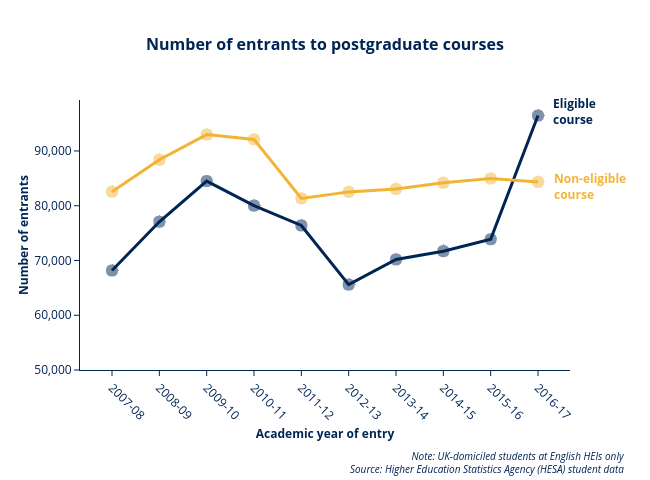New data from the Office for Students shows an increase in postgraduate masters’ student numbers since the introduction of the postgraduate masters’ loan.

The new data (Note 1) is published alongside data from the Intentions After Graduation Survey (Note 2), which shows that the proportion of students who state their intention to continue their studies and end up going into postgraduate education has increased.
In 2016 the government introduced postgraduate masters’ loans of up to £10,000 to assist students with tuition fees and living costs. Between 2015-16 and 2016-17 there was a large increase in entrants studying eligible masters’ courses, from 73,880 to 96,465, over 22,000 additional students (Note 3).
The proportional increase was largest among students from the following groups:
- students from low participation areas
- black students
- students who declared a disability
- students aged 25 and under.
On graduation from their undergraduate degree, students who qualified in 2015-16 were surveyed on their intentions after graduation. This enabled us to see which student groups were not planning on progressing to postgraduate study, and what was preventing them (Note 4).
The student groups that have seen a particularly large increase in realising their intentions to study at postgraduate level are students from low participation areas and black students. These groups had previously identified finance as a significant barrier to carrying onto their studies.
Office for Students director for fair access and participation, Chris Millward said:
‘Postgraduate loans have enabled more graduates to realise their ambitions to study at masters’ level. We knew from research (Note 5) that finance plays a major part in the ability of individuals to undertake postgraduate study.
‘There is a long way to go to address gaps in the participation and progression of underrepresented groups in higher education, including at postgraduate level, but it is encouraging to see that the largest increases in those taking up postgraduate study are among those from the most under-represented groups.’
Notes
- The effect of postgraduate loans data.
- Intentions After Graduation Survey data.
- The HESA Student record has been collected since 1994-95 from subscribing higher education providers. A wide range of data is collected, including student entry profiles and personal characteristics, module and course level data, funding information and qualifications awarded.
- The Intentions After Graduation Survey, which has been run since 2013, asks final year undergraduates about their future plans, including plans for postgraduate study. It is an optional online survey attached to the end of the National Student Survey.
- The Postgraduate Support Scheme provided scholarships to contribute to the costs of masters’ study. The scheme built on key findings from the pilot Postgraduate Support Scheme in 2014-15, which showed that finance is a key barrier to progression for the most underrepresented students.
- The effect of postgraduate loans on the non-continuation rates and employment outcomes of the graduates will not be known until early 2019.

